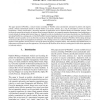968 search results - page 162 / 194 » Evaluating Benchmark Subsetting Approaches |
ECCV
2010
Springer
13 years 7 months ago
2010
Springer
Abstract. Multiple-instance learning (MIL) allows for training classifiers from ambiguously labeled data. In computer vision, this learning paradigm has been recently used in many ...
SIGGRAPH
1997
ACM
13 years 12 months ago
1997
ACM
This paper describes an algorithm for automatically adapting existing simulated behaviors to new characters. Animating a new character is difficult because a control system tuned...
SP
2010
IEEE
13 years 11 months ago
2010
IEEE
—To handle the growing flood of malware, security vendors and analysts rely on tools that automatically identify and analyze malicious code. Current systems for automated malwar...
LREC
2010
13 years 9 months ago
2010
This paper presents Q-WordNet, a lexical resource consisting of WordNet senses automatically annotated by positive and negative polarity. Polarity classification amounts to decide...
IJSNET
2007
13 years 7 months ago
2007
: Many applications developed for wireless sensor networks (WSNs) demand for Reliable communication service, since majority of these applications are event-critical applications. T...

